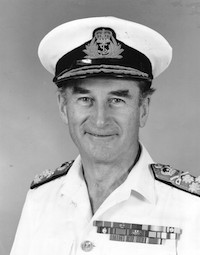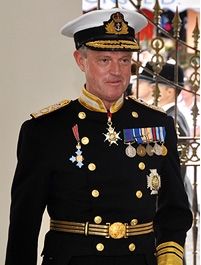Related Research Articles

Admiral of the Fleet Michael Cecil Boyce, Baron Boyce, was a British Royal Navy officer who also sat as a crossbench member of the House of Lords until his death in November 2022.
Admiral of the Fleet Sir David Benjamin Bathurst, is a former Royal Navy officer. He is the only living person, apart from King Charles III, holding the rank of Admiral of the Fleet in the Royal Navy since the death of Lord Boyce. After training as a pilot and qualifying as a helicopter instructor, Bathurst commanded a Naval Air Squadron and then two frigates before achieving higher command in the navy. He served as First Sea Lord and Chief of the Naval Staff from 1993 to 1995: in that capacity he advised the British Government on the deployment of Naval Support including Sea Harriers during the Bosnian War.

Admiral of the Fleet John David Elliott Fieldhouse, Baron Fieldhouse, was a Royal Navy officer. He commanded five submarines and a frigate before achieving higher command from the 1970s. Following the invasion of the Falkland Islands by Argentine forces in April 1982, Fieldhouse was appointed Commander of the Task Force given responsibility for "Operation Corporate", the mission to recover the Falkland Islands. The campaign ended in the surrender of Argentine forces in June 1982. He became First Sea Lord and Chief of Naval Staff in December that year and, in that role, persuaded the British Government to fund the replacement of ships lost in the Falklands War. He went on to be Chief of the Defence Staff from 1985 until his retirement in 1988.

Rear Admiral Sir David James Martin, was a senior officer of the Royal Australian Navy and later Governor of New South Wales. He also established the Sir David Martin Foundation to assist young Australians in crisis.
Admiral Sir John Jeremy Black,, known as Jeremy Black or J. J. Black, was a senior Royal Navy officer. He commanded the aircraft carrier HMS Invincible during the Falklands War, and later served as Commander-in-Chief Naval Home Command from 1989 until his retirement in 1991.

Admiral of the Fleet Sir John Julian Robertson Oswald was a senior Royal Navy officer. After training as a gunnery specialist, Oswald commanded a frigate and then a destroyer before achieving higher command in the navy. He served as First Sea Lord and Chief of Naval Staff in the early 1990s. In that capacity he advised the British Government on the reduction in the size of the fleet under the Options for Change restructuring programme and on the deployment of Naval Support for the Gulf War in 1991: he also made the decision that members of the Women's Royal Naval Service should be allowed to serve in Royal Navy ships.

Admiral Sir Anthony Monckton Synnot, was a senior officer in the Royal Australian Navy, who served as Chief of the Defence Force Staff from 1979 to 1982.

Admiral of the Fleet Sir Varyl Cargill Begg, was a Royal Navy officer. He fought in the Second World War as gunnery officer in a cruiser taking part in the North Atlantic convoys, the Norwegian campaign and the occupation of Iceland and then as gunnery officer in a battleship operating in the Mediterranean Fleet during the Battle of Cape Matapan. After that he commanded a destroyer during the Korean War and was Commander-in-Chief of Far East Command during the Indonesia–Malaysia confrontation. He was First Sea Lord and Chief of the Naval Staff in the late 1960s. In that role he vehemently opposed plans to introduce large new aircraft carriers and instead managed to persuade the British Government to develop the design for three small "through-deck cruisers".

Vice Admiral Sir Adrian James Johns, is a former senior officer in the Royal Navy, serving as Second Sea Lord between 2005 and 2008. He was the Governor of Gibraltar between 2009 and 2013.
Admiral Tariq Kamal KhanNI(M) HI(M) SI(M) LoM, is a retired four-star rank admiral and a former diplomat who served as a Chief of Naval Staff (CNS) of Pakistan Navy from being appointed in 1983 until retiring from his service in 1986.

The Royal Naval College, Greenwich, was a Royal Navy training establishment between 1873 and 1998, providing courses for naval officers. It was the home of the Royal Navy's staff college, which provided advanced training for officers. The equivalent in the British Army was the Staff College, Camberley, and the equivalent in the Royal Air Force was the RAF Staff College, Bracknell.

Commodore Submarine Service is a post in the Royal Navy which involves command of the Royal Navy Submarine Service. It evolved from the post of Inspecting Captain of Submarines in 1901 and would later evolve to become the post of Flag Officer Submarines in 1944.

Admiral Sir Antony David Radakin, is a senior Royal Navy officer. He was appointed Chief of the Defence Staff, the professional head of the British Armed Forces, in November 2021. Radakin was previously the First Sea Lord, the professional head of the Naval Service from June 2019 to November 2021. He was Chief of Staff, Joint Forces Command, from 2016 to 2018, and the Second Sea Lord and Deputy Chief of the Naval Staff from 2018 to 2019. He was appointed Lord High Constable of England in 2023, and in that role took part in the Coronation of Charles III and Camilla.

Admiral Sir Benjamin John Key, is a senior Royal Navy officer. He has served as First Sea Lord since November 2021. He has commanded HM Ships Sandown, Iron Duke and Lancaster, and deployed on operations to Kosovo and Iraq. He was appointed Fleet Commander in 2016, and the Chief of Joint Operations in 2019.
Rear-Admiral Hugh Maxwell Balfour was a Scottish Royal Navy officer.

The Assistant Chief of the Naval Staff (Aviation, Amphibious Capability & Carriers) formerly the Assistant Chief of the Naval Staff (Aviation and Carrier Strike) is a senior Royal Navy appointment responsible for naval aviation. The post is also the successor to the Royal Navy's Flag Officer for naval aviation in the British Isles, established since 1939.

The Flag Officer, Royal Yachts, (FORY) also styled Flag Officer Commanding Royal Yachts was a senior Royal Navy post that existed from 1884 to 1997.
Rear Admiral Peter Gerald Hammersley CB OBE was an English Royal Navy officer who served from 1946 to 1982. Hammersley won a scholarship to Britannia Royal Naval College to train as a deck officer but his eyesight was too poor. Instead, he chose to become an engineer and studied at the Royal Naval Engineering College from 1946 to 1950. He trained onboard HMS Frobisher and HMS Duke of York and served on HMS Ocean during the Korean War. Hammersley specialised in submarines from 1954 and in 1959 served on secondment to the US Navy on the nuclear submarine Nautilus. In 1960 he became the first marine engineering officer to serve aboard the Royal Navy's first nuclear-powered submarine, HMS Dreadnought. Hammersley helped design the Swiftsure-class of submarines and commanded a number of shore installations including the Royal Naval Engineering College. He served as aide-de-camp to Queen Elizabeth II and was Chief Staff Officer Engineering for the fleet in the 1982 Falklands War. After retirement in 1982 he served in roles in a number of commercial and charitable organisations.
Rear Admiral Ian Alexander Hunter was an officer of the Royal New Zealand Navy, who served as Chief of Naval Staff from March 1991 to April 1994.
References
- ↑ "Garnier, Rear-Adm. Sir John", Who's Who (online ed., Oxford University Press, December 2018). Retrieved 1 July 2019.